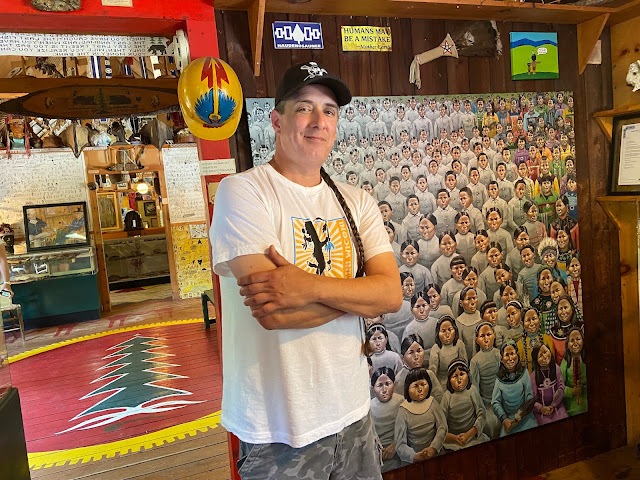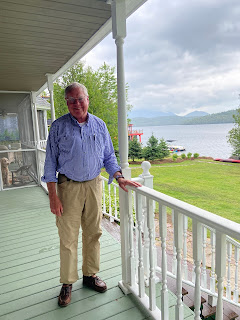Artists of the Adirondacks: David Kanietakeron Fadden
The faces in David Kanietakeron Fadden’s paintings grab you immediately, they are full of joy and kinetic energy. I was able to interview David at the Six Nations Iroquois Cultural Center in Onchiota, New York, where many of his paintings are currently on exhibit. David, who is an Akwesasne Mohawk and whose name Kanietakeron means Patches of Snow, helped me understand how attaining this skill to portray such emotion had been a process. He remembers the moment that he was leaving the Metropolitan Museum of art, and nearly out the door when he saw in one of the last rooms, a portrait of Benjamin Franklin. Although David had already been painting for many years, he felt that portraying expression and human anatomy were eluding him. When he saw the paint strokes, reflections of color on the skin, and softness of Franklin’s portrait at the Met, he described the moment as “jaw dropping,” and it inspired him to learn how to accomplish the same. For David, painting faces full of life and expression is fundamental to his art and evident in the work he has on exhibition at Six Nations.
Once the Cultural Center reopened this summer, a trip to Onchiota where it is located in a beautiful rural setting was a priority. Because of the lack of glitzy publicity about Six Nations, and some modest signage on the highway, I was not expecting to find the breadth of history, art and artisanry on display. The Six Nations of the Iroquois Confederacy are the Mohawks, the Senecas, the Onondagas, Oneidas, Cayugas, and Tuscaroras. The Center welcomes visitors, student groups and those who come to learn about the history, culture, contemporary realities, and the potential futures of Native Nations.
Even with so much to see and read, I could not turn away from a painting in the entrance to the museum, Kill the Indian…Save the Man, Fail. I had to know more about the artist as well as the background to the painting. I’ve since learned that the forced institutionalization of indigenous children into euphemistically called “boarding” schools, was widespread in both the United States and Canada. In recent years, the unmarked graves of children have been found near these schools and the numbers are staggering. I was even surprised to learn that this includes the Chemawa Indian School in Salem, the capital of Oregon where I lived in the 1980’s. The school is still operating as of 2021. As if the indignity of the forced separation of the children and culture wasn't enough, children who lived and then died at these “schools” under abusive conditions were often not acknowledged, but rather buried in unmarked graves. David was inspired to express his feelings about this collective trauma through this painting. He also wanted his painting to help educate others.
The title of the painting is based on the words attributed to Richard Henry Pratt, an American general who established the first off-reservation boarding school for Native Americans in Carlisle Pennsylvania, and was credited with using the expression, “Kill the Indian, Save the Man.” While Pratt considered this as enlightened, it is now recognized as a form of cultural genocide.
David's painting has an emotional impact, possibly due to the unique expression on each child’s face. Reflecting a great deal of labor, no two faces in the painting are alike, although on the left side of the canvas, the grief, anger, disassociation are there for the viewer to experience. The colors are bleak and almost monochromatic. On the right side of the canvas we see children with expressions of joy and pride, wearing clothing full of color and cultural identity.
Over the years, David sought inspiration in the faces of indigenous people by looking at old photos taken in the 1800s and 1900s. David noticed that the expressions were often very somber. They did not reflect the joy and love that he experienced within his own culture. He realized that these photos were often taken in the days when the person being photographed was told to stay still. It did not necessarily portray the people as they were, but regretfully, artists used these photos as references in painting, and this is how they portrayed indigenous people, the “stoic Indian.” It is clearly a mistake David has successfully avoided.
David was also not completely satisfied. Challenged by the anatomy, foreshortening and proportions of faces, he worked to solve how to use paints to do what he wanted. He admires the work of the masters Rembrandt and Michelangelo, who had the skill to render their subjects with precision, but with a style that is uniquely recognizable. David is also a fan of illustrator Norman Rockwell, and how he is able to capture emotion. “When you look at an image of Rockwell’s, you know what is going on.”
As I walked through Six Nations, I discovered another favorite, He Peers through the Trees. The title is a loose translation of his grandfather Ray’s Mohawk name Tehanetorens. “The meaning reflects when one is in the forest and looks between the trees to see ahead. It is a name that is a perfect match for my grandfather and his ability to navigate through the woods. He was very good in the forest.”
David grew up in an environment encouraging of art and culture. It was his grandfather Ray and grandmother Christine who founded the Six Nations Museum in 1954 and the wood building is today bursting at the seams with artisanry, historical pieces and pen and ink historical placards painted by David’s father John. Helping his grandfather during the summer months, and listening to him tell visitors stories of Mohawk and other history, he received an education that has given him a strong underpinning as an artist and as a member of the community. It also gifted him with his own power of storytelling. I found it remarkable the day I visited the Center, how willing David was to answer questions about his paintings and just about anything without any sign of impatience.
In fact, David uses his talent and craft as a storyteller to entertain and educate children and adults of all ages. Storytelling is a way of using words to create images. He finds his most attentive audiences are at opposite ends of the spectrum, third and fourth graders, and senior citizens. David enjoys the opportunities to interact with both young and old. The second time I interviewed him, there was an enthusiastic group of college students arriving. David was asked to speak about whatever he wanted!
While David was already a talented artist as a teen, and received recognition and prizes for his work, he also learned some from his father, a skilled artist who has illustrated some 70 books, and his mother, Elizabeth, a wood carver and clay artist. He was also given guidance by his Aunt Marita Thompson, an art teacher. But David developed his own style, and he sought out college art classes. He did not yet consider himself an “artist,” although he was already being hired for art related projects, including illustrations for a book series, set design in museums, and a collaborative work with the Museum of the American Indian about the constellations. David also worked for a newspaper in graphics and layout for many years. and gained insights as to what draws the viewer’s eye.
David is now a well known artist and storyteller and his artwork is in high demand, but commercial success has never been his primary goal. Gallerist Deborah Geurtze, co-owner of Abstract-ADK.com in Saranac Lake, and a life-long artist herself, believes that David has skillfully merged his deep family and cultural influences with his imagery in a very powerful, almost explosive way. "I consider David to be one of the most important artists emerging in the Adirondacks, and on the national scene."
At this moment, the expansion of the Six Nations Iroquois Cultural Center is a project that lights up his face! David and his family are actively involved in planning for the construction of a new building, which will not only allow expanded displays and spaces for cultural events, but the opportunity to be open year round, as the current space has no heating or cooling. The original wood museum building built by Ray will be preserved and on display within the new museum. I must be among many who can’t wait to see the new space and to see future displays of David’s work!
To see more of David’s work go to:
https://www.facebook.com/dave.fadden.9/
For more about Six Nations Iroquois Cultural Center go to: https://www.6nicc.com/
See also https://abstract-adk.com/
See also: https://www.adirondackexplorer.org/stories/david-kanietakeron-fadden





Comments
Post a Comment